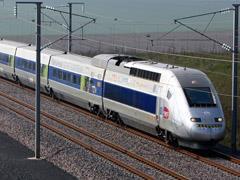
THE PROSPECTS for Europe's growing high speed rail sector are 'very positive', according to the Chief Executive of French National Railways, Guillaume Pepy. But operators need to work together more closely if rail is to boost its market share.
Looking back over the 25 years since SNCF opened the first stage of TGV Paris Sud-Est, Pepy said on May 24 that 'northern Europe has already developed an efficient network, and has the most favourable characteristics for promoting high speed services'.
The cut-off point in journey times between rail and air has risen from 3h to 4h, which Pepy attributes to increased security at airports and urban congestion at each end. Rail's share of Paris - Marseille traffic has risen from 22% in 1999 to 65% in 2005, thanks to TGV Méditerranée. Even for Toulon, which is 4h from the capital, SNCF now has 50% of the market.
With several new lines due to open in 2007 and more on the drawingboard, Pepy expects the volume of high speed passenger traffic in Europe to rise from 179 million journeys in 2005 to 270 million by 2015. By then it should be possible to travel 1450 km from Amsterdam to Sevilla entirely on new line. In 2009 SNCF and Renfe will launch through Paris - Madrid TGVs, linking the French and Spanish capitals in 6h.
However, Pepy warns that high speed rail will only be successful if prospective passengers can identify the network as an entity. 'A true European network already exists', he claimed, 'but it is absolutely split' in the eyes of potential travellers. Different operators, different branding, and the difficulty of obtaining through tickets at attractive prices have combined to fragment what should be an integrated and competitive business.
Whilst the European Union continues to favour on-rail competition (left), Pepy argues that the passenger needs clarity and convenience. Citing the 10th anniversary of the Thalys joint venture on June 1, he is backing a common marketing and ticketing platform, as envisaged in his Railteam proposal (RG 3.05 p141).
Meeting in Berlin on June 14, senior representatives of SNCF, DB, NS, SNCB, SBB and ÖBB signed a Letter of Intent for co-operation in the provision of international high speed rail services, agreeing to work towards common quality standards and greater customer convenience to improve their competitivity against the airlines.
Asked whether such a move would be seen as an anti-competitive cartel, Pepy insisted common marketing did not mean a unified product, suggesting that each operator would still be able to differentiate their services in terms of quality and price.
But in the longer term, Pepy believes that EU policy could see the merger of business units spun out of the old national railways to form 'fully-fledged pan-European companies', co-operating and competing on the principal corridors much as the airlines do today.




















